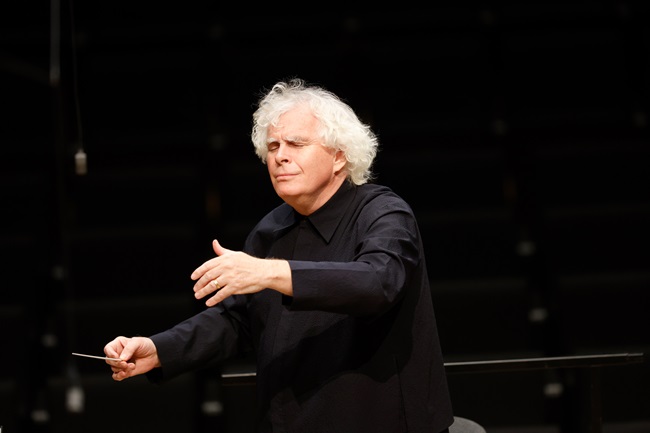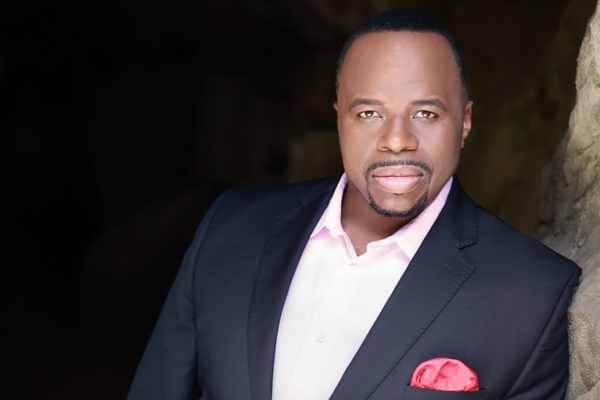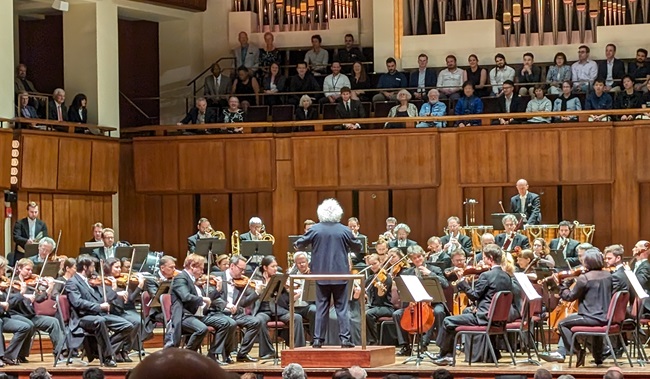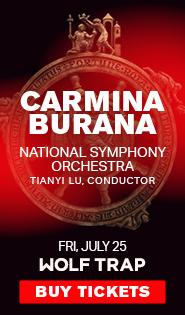Rattle returns to Washington with Bavarian RSO in richly varied program

Conductor Simon Rattle. Photo: Astrid Ackermann
The Bavarian Radio Symphony Orchestra has entered a new era this season with their new music director, Simon Rattle. This esteemed orchestra last visited Washington in 2016, under the baton of Rattle’s predecessor, the late Mariss Jansons. Washington Performing Arts brought them back to the Kennedy Center Concert Hall Tuesday night, for the second stop of a four-city American tour that opened Sunday in Chicago.
Rattle elicited a rich and expressive sound in the opening of the Act I Prelude to Wagner’s Tristan und Isolde, with a throbbing sense of surge and release in the strings that suited this chest-heaving music. The woodwinds answered with a solid and enigmatic take on the famous chord, representing the fateful love of the title characters, that is not resolved until the end of the opera, with their death.
Rattle allowed the first section of the Prelude to unfold slowly, but by ramping up his tempo too rashly later, he went for short-term intensity rather than a more measured build-up to loud climaxes. The orchestral arrangement of the “Liebestod,” which can be an even longer burn than its original vocal version, also felt cheated by similar choices. The big crest of its musical wave and the resolution of that enigmatic chord from the Prelude went by too quickly, regrettable given how beautifully the orchestra’s sound gleamed.
Alexander von Zemlinsky’s Symphonische Gesänge made an inspired choice for an American tour. The Austrian composer set seven texts from Anna Nussbaum’s German translation of poems from the Harlem Renaissance, Afrika Singt, in this orchestral song cycle. American bass-baritone Lester Lynch sang the vocal part with a ferocious sense of outrage. The dark opening song, “Lied aus Dixieland,” set a text by Langston Hughes (“Song For A Dark Girl”) about a lynching. The singer’s dignified, poignant sound wove together with softly discordant violas and cellos, ending with a lonely section for solo viola and two violins.

Bass-baritone Lester Lynch. Photo: Rex Lott
Brass crowned the fuller orchestration of “Lied der Baumwollpacker” (Jean Toomer’s “Cotton Song”), with Lynch evoking the loud work calls of cotton balers. The D.C.-born poet, whose father was formerly enslaved in North Carolina, wrote in a southern dialect difficult to translate into German but that came across in Lynch’s rough-hewn performance in this song. Although the orchestra was vast in size, Zemlinsky often favored chamber-sized combinations of instruments as in the mournful “Totes braunes Mädel” (Countee Cullen’s “A Brown Girl Dead”).
The spiteful anger of “Übler Bursche” (“Bad Man” by Langston Hughes) roiled in the animated violence of triangle and snare drum, accenting Lynch’s crowing vocal line. A plaintive oboe solo set the tone of “Erkenntnis (“Disillusion” by Hughes), matched by more suave legato sound from Lynch. Although Zemlinsky avoided overt reference to American jazz, a tense beat of percussion ran through the cycle, pulsing on woodblock, timpani, and side drum.
That use of percussion lined up with the text of Hughes’s “Danse africaine” in the sixth song, with its references to “the low beating of the tom-toms,” although it sounded more like Stravinsky than anything African or American. The cycle’s taut mixture of anger and love came to a high point in the final song, set to Frank Horne’s “Arabesque,” contrasting lynching and racist language with the innocent love between a white child and black baby, leaving behind contradictions instead of resolution.
Rattle put his strongest mark on Beethoven’s Sixth Symphony, distinguished by some subjective extremes of pacing and dynamics. Explaining the work’s subtitle (“Pastorale”) before the orchestra’s pre-tour performance in Munich, Rattle said, “It is the human being in nature; it is not nature. It is how the human being reacts.” Beethoven, who loved walking through nature, put it similarly when he said the score was “more the expression of feeling than painting.”
The tempo of the first movement did not quite settle early on. In place of the precision of this orchestra under Jansons, Rattle preferred more spontaneity, often opting to cue and shape more than micromanage the tempo. The highlight was the plush softness of the second movement, which flowed without any sense of hurry. The charming woodwind cadenza sounded especially avian, with the flute’s nightingale, the oboe’s quail, and the clarinets’ cuckoo set at a leisurely pace, not really lining up metrically, as birds would not.
The third movement’s country gathering started off joyously and grew more raucous, especially the bustling clarinet lines and horn calls, until the fourth movement’s storm drew near. As clouds seemed to darken, Rattle went for a dramatic shift of mood. The sudden loud entrance of the timpani, silent in the score until this moment, actually caused some listeners to jump slightly. The double-bass section excelled in their starring role as rumbles of distant thunder, which gradually subsided.

Simon Rattle conducted the Bavarian Radio Symphony Orchestra Tuesday night in the Kennedy Center Concert Hall. Photo: WCR
The finale, evoking “thankful feelings after the storm,” was tender and drawn out in an elegiac way. Rattle has spoken of the sadness that he feels permeates this movement, as if mourning those lost in the storm. Both the woodwind imitation of a shepherd’s pipe and the answer given by the horns sounded with reverent awe, a feeling continued by the violins as they took up the movement’s theme. It rounded out a fine, unexpected reading of this familiar work.
Rattle’s joking question (“Shall we play something else?”) being met with extended applause, the orchestra obliged with Dvořák’s Slavonic Dance in C Major (Op. 72, no. 7). This spirited, athletic piece sent the audience home in an even happier mood, as the members of the orchestra embraced one another with collegial joy.
Pianist Evgeny Kissin performs a recital of music by Beethoven, Chopin, Brahms, and Prokofiev 2 p.m. May 11. washingtonperformingarts.org

